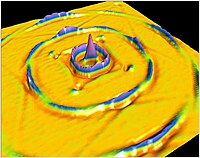
Photo from wikipedia
An analytical approach based on the linear potential theory is employed to enlighten the fundamental physics of atomization of droplets with an impinging sound wave, with a particular application in… Click to show full abstract
An analytical approach based on the linear potential theory is employed to enlighten the fundamental physics of atomization of droplets with an impinging sound wave, with a particular application in surface acoustic wave (SAW) atomization. When a plane sound wave, originated from the gas or the liquid side (resembling SAW), impinges on a liquid droplet, capillary waves are generated. It is shown that, for both cases, spatial phase-locking between the sound spherical modes and the free surface oscillations occurs. Hence, capillary waves will have the same spatial modes of the sound wave. The frequency spectrum analysis shows that the phase-locking causes two types of waves: the natural capillary waves with a wide range of frequencies, two to five orders of magnitude smaller than the impinging sound wave, and the forced wave, with a frequency equal to that of the sound wave. Since the instability of these surface waves leads to separation of droplets from the surface and the size of these droplets is correlated with the wavelength of the surface waves, this well explains the previous observations that droplets with a wide range of sizes are generated in the SAW experiments. Finally, a correlation is also proposed for predicting the atomized droplet size, which gives the size order for the generated droplets in SAW with good accuracy. The correlation could also suggest the possible size for remote atomization of the droplets by sound wave propagated in gas.
Journal Title: Physics of Fluids
Year Published: 2020
Link to full text (if available)
Share on Social Media: Sign Up to like & get
recommendations!